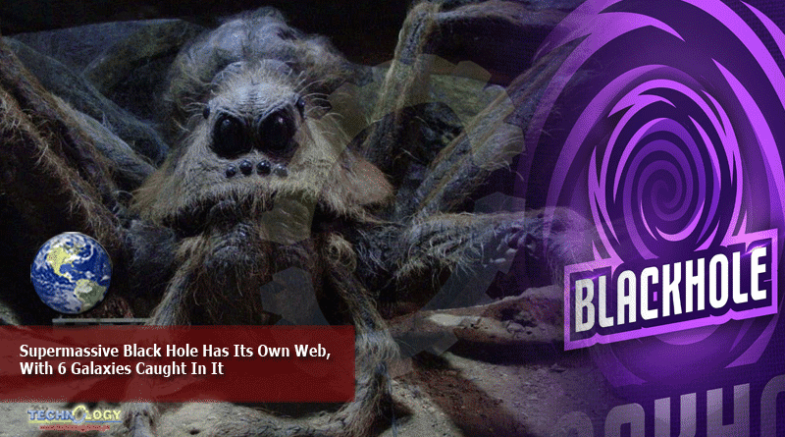Black Holes Are Space Spiders Waiting For Photons And Particles To Fall In To Their Hungry Jaws, But One Supermassive Black Hole…

even has its own web — with six galaxies caught in it.
This spider of a black hole first emerged when the universe was barely a billion years old and grew to gargantuan size almost as fast as Hagrid’s acromantula Aragog (above) from Harry Potter and the Chamber of Secrets. Astronomers who used ESO’s Very Large Telescope (VLT) to peer into space as it was billions of light years away, meaning billions of years back in time, have observed an unusual structure that an actromantula wouldn’t mind hanging out in. A supermassive black hole lies in the center, surrounded by six galaxies and filaments of gas and dark matter that gave the structure the appearance of a cosmic spiderweb.
“This is the first spectroscopic identification of a galaxy overdensity around a supermassive black hole in the first billion years of the Universe,” astronomer Marco MIgnoli, said in a study he recently led, published in Astronomy and Astrophysics. “Our finding lends support to the idea that the most distant and massive black holes form and grow within massive haloes in large-scale structures.”
Mignoli believes that nothing like this has been observed before because there was no telescope with advanced enough vision to make it out. From Earth, his team was seeing the structure as it was when the universe was only 0.9 billion years old, which is unfathomable to us but nothing much in the infinite realm of the cosmos. The mystery that glowed from so far away was how black hole itself blew up to a billion solar masses. Black holes are the corpses of collapsed stars, so it must have been one of the first stars to have reached its demise, but it also would have needed an immense amount of fuel to grow to its super-supermassive size. That could explain why it lurks inside a spiderweb.
Far from being designed to ensnare prey like the webs that actual spiders spin, this web and the six galaxies (at least six the telescope could see) whose faint light glimmers within it pretty much are the prey that this monster black hole feeds off of. It’s more of a parasite than a hunter. Dark matter does not release energy, but it exerts a strong gravitational pull on baryonic matter. It is believed that the dark matter in the web filaments has enough gravitational power to attract an enormous amount of gas. This gas gets caught in the black hole’s accretion disc and eventually falls past the event horizon and into the gravity trap from which not even light can escape.
The VLT was able to detect the spiderweb through its redshift, or light whose wavelengths stretch towards the infrared part of the spectrum so it appears to have shifted. Infrared wavelengths are too long for the human eye to observe. Even the telescope had issues because surrounding noise obscured the infrared range, but at least the chance of successfully measuring a redshift on a structure is the same whether that measurement is taken from the inside or outside. Because this structure is so distant, there is a chance that there are other galaxies in or around the spiderweb that are too faint to detect yet. That might change when the upcoming Extremely Large Telescope takes another look at this oddity.
“Although simulations suggest that [supermassive black holes] in the early universe should reside, on average, in the most massive dark matter haloes formed at that time, a large variance in the galaxy number counts around them is nevertheless expected,” Mignoli said.
So maybe David Bowie wasn’t completely right when he sang about the spiders from Mars in his Ziggy Stardust persona, but he had no idea something even more fantastical was out there.
This news was originally published at syfy.com
